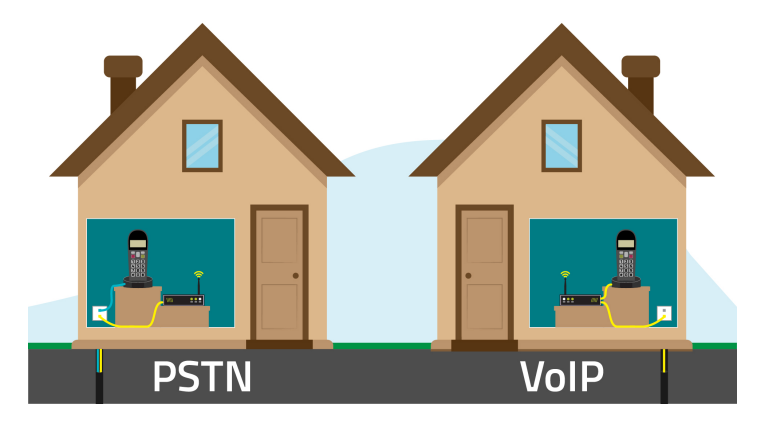What the PSTN switch-off means for your business
Many businesses have been receiving emails from their broadband providers urging them to make changes due to the “big switch off”.
This is not an excuse or marketing spam but a for legitimate reason; it’s just often ill-explained.
This article explains the impact of the big switch off for British businesses.
- The “switch off” is the planned shutdown of the old PSTN landline, scheduled for January 2027.
- Most businesses will be unaffected as their new broadband contracts have already migrated them onto VoIP digital landlines.
- Companies on full fibre business broadband, cable, SoGEA, satellite or 5G business broadband will be unaffected.
- Businesses on FTTC or ADSL broadband may need to migrate. Expect a message from your business broadband provider for instructions.
- Businesses outside the cellular network or still relying on PSTN devices like fax machines and old alarm systems will be directly affected.
What is the PSTN big switch-off?
The “PSTN Switch-Off” or “Big Switch-Off” is the UK telecom industry’s planned shutdown of the PSTN traditional telephone network, scheduled for January 2027.
Any devices running on this older network, including older phones, fax machines and some alarm systems, will stop working.
Fortunately, all homes and businesses in the UK should have migrated onto digital business phone lines voluntarily or supported by at least one broadband provider by this time.
Once switched onto internet-based system, your landline will keep the same number and operate normally. The only real change is the underlying technology supporting it.
Technically speaking, PSTN-based landlines will cease and be entirely replaced by VoIP landlines that rely on the internet to transmit voice signals.
The switch-off should be largely uneventful, as the industry will have been preparing for a decade when it happens. If your company is already on a full fibre or cable business broadband connection with a “landline”, your provider has already migrated your line. You don’t need to do anything else.
If your business’s telecommunications (e.g., landline, broadband, fax, alarms, patient telecare) are over a decade old, it is worth being proactive and upgrading to digital equivalents where necessary to ensure your business is unaffected.
The same applies to businesses outside the coverage of business mobile broadband networks or those with a landline but no broadband.
In any of these cases, your business broadband provider will (and likely has already) contact you with instructions.
For more information about PSTN, ISDN and VoIP technologies, see our FAQs.

What will happen when PSTN is switched off?
When PSTN circuits are permanently switched off in January 2027, any system still relying on it will be rendered useless. This is what will happen to some technologies:
ADSL and FTTC-bundled landlines will be switched off
ADSL and FTTC are broadband technologies typically sold as ‘bundles’ with traditional landlines that rely on telephony copper cables. While the broadband does not depend on PSTN, the landline does.
When PSTN is switched off, landlines bundled with ADSL or FTTC deals will stop working. This is unlikely to pose a problem though, as the industry has been taking the following steps to unwind them before January 2027:
- PSTN Stop-Sell: Since September 2023, FTTC or ADSL has no longer been offered to homes and businesses in the UK in areas where full fibre is available, so their numbers are rapidly dwindling as contracts end.
- SoGEA: In areas without full fibre, FTTC is being replaced by a no-landline alternative called SoGEA, which keeps the broadband aspect but completely removes the traditional phone connection. Upgrade to a SoGEA connection today with our business broadband comparison service.
- ADSL: In the most remote areas without any fibre optic business broadband, ADSL will continue to operate as the only tethered broadband alternative. Providers will formulate no-landline ADSL deals that come with digital telephony instead. A re-brand like SoGEA is unlikely due to these being isolated cases.
For example, BT business broadband is ensuring all of its customers have a router that can support VoIP calls on their premises, so migrating simply involves unplugging their existing phone from the wall and plugging it into their router.
For more information refer to our article on business broadband without a landline.
Landline-only services will continue to be supported
A niche community of businesses lives fully “offline” without a generic internet connection. This customer base relies on landlines for communications, and regulations legally protect their access to them.
The Telephony Universal Service Obligation in the 2003 Communications Act states that all consumers in the UK will still have access to a landline service should they choose to do so.
This means that at least one service provider will always offer a “landline only” deal. However, the PSTN switch-off means this will need to be an internet-based digital landline supported by a business broadband router.
PSTN-reliant systems need replacement
Many businesses in the UK have not updated their systems in decades and continue to rely on older PSTN-dependent versions.
These include:
- Burglar and fire alarm systems using PSTN lines.
- Personal emergency alarms (pendant alarms) for vulnerable individuals.
- Traditional fax machines.
- Older credit card payment terminals (POS systems).
- Remote telemetry systems for utilities and industrial monitoring.
- Lift (elevator) emergency phones.
- Traffic light control systems using PSTN.
- Environmental monitoring systems (e.g., reservoir levels).
- Legacy ISDN PBX systems in businesses.
If this is you, you must replace these with broadband-based alternatives if you want to continue using them after January 2027.
Receive a backup battery
One advantage of PSTN landlines is that they are immune to power cuts. They carry a low-voltage power connection directly from the telephone exchange, sufficient to power basic corded handsets without a power source.
Conversely, broadband-based landlines rely on an independent power supply and won’t work during powercuts unless a generator or battery system supports it.
Ofcom requires telecom companies to take all necessary measures to ensure uninterrupted access to emergency organisations for their customers, including in the event of a power cut.
Most businesses can roam any national cellular network for emergency calls. However, those outside the cellular network may request a backup power source to access emergency calls through their business VoIP provider, as the switch essentially removes this service.
The PSTN Switch-Off timeline
The PSTN Switch Off is scheduled for January 2027 but was originally set for December 2025.
BT announced this delay to allow more time for a smoother transition, particularly to ensure that vulnerable customers, such as those using telecare services, are adequately supported during the migration.
Regardless of these changes, this event is simply another stepping stone in the irreversible switch into fully digital communications.
For context, here is the timeline of how the switch off events have unfolded so far:
| Date | Event |
|---|---|
| 2017 | UK Telecoms industry announces plans to phase out traditional landline technologies, transitioning to digital services like VoIP and fibre optics. |
| December 2020 | ISDN and PSTN circuits are no longer offered to businesses in the UK. |
| September 2023 | "PSTN Stop-sell" order begins, in which broadband providers stopped selling traditional landlines in areas with sufficient fibre coverage. |
| December 2023 | Ofcom orders a pause on non-voluntary migrations to address customer concerns and support vulnerable users is implemented. |
| December 2025 | Original switch-off deadline for PSTN and ISDN; extended due to migration complexities. |
| January 2027 | Revised deadline for the complete switch-off, requiring all users to transition to digital services. |
| Post-2027 | Full decommissioning of PSTN and ISDN, with a focus on expanding fibre-optic networks. |
The benefits of the big switch off to your business
Besides the faff of change, there are a few notable advantages that switching to a broadband-bases system brings:
- Faster and more reliable communication with digital systems (except during power cuts!)
- Enhanced VoIP features like call forwarding, anonymous caller rejection, and three-way calling.
- Lower maintenance costs as digital networks are easier to manage.
- Improved scalability, allowing your business to add or remove lines easily.
- Better integration with modern communication tools, such as video conferencing and instant messaging.
- Greater flexibility with remote working, as business VoIP systems can be used from any location with an internet connection.
- Potential cost savings on calls, especially for long-distance and international communication.
PSTN Switch Off – FAQs
Our business broadband experts answer commonly asked questions on the big switch-off:
What is PSTN?
PSTN is the traditional analogue telephone network used for voice communication since the 1800s. It uses copper wires and circuit-switched technology to connect calls between locations. PSTN has been the backbone of landline telephone services, but it is now being phased out in favour of digital communication systems like VoIP.
What is ISDN?
ISDN is a digital telecommunication network introduced in the 1980s. It allows transmitting voice, video, and data over traditional copper telephone lines.
ISDN provides multiple digital channels, offering better call quality and faster data transmission than PSTN. It has been widely used in business settings for video conferencing and multi-line phone systems but will also be phased out in January 2027.
What is VoIP?
VoIP is a broadband-based telephony technology that allows voice calls to be made over the Internet or other IP-based networks. Here is how VoIP works in our business essentials guide.
Will telephone copper wires be removed during the big switch-off?
No, the big switch-off only involves switching off the PSTN circuits. While the copper cables will need to be decommissioned soon after, this will happen gradually. Areas without fibre optics cables still rely on them for telecommunications.
What should my business do to prepare for the switch-off?
Most likely, nothing at all! See our summary here.

